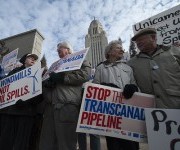Cross-posted from the Council on Foreign Relations.
Bryan Walsh, writing at TIME, is right: Bill McKibben and the Keystone XL protestors have pulled off something pretty impressive. I’m not talking about the merits of the indefinite delay to the pipeline that the State Department announced yesterday — the substantive case for blocking Keystone is weak. But you’d have to be pretty blinkered not to acknowledge that, purely as a matter of organizing and impact, the anti-Keystone movement is punching way above its weight.
Whether it can translate this victory into something bigger, though, is an entirely different question. I want to explain in this post why I think that the tactics and coalitions that have been deployed to block the pipeline are ill designed to making major progress on climate change — and, indeed, why they may backfire.
The anti-Keystone protesters have taken a page out of the Tea Party playbook. Tea Partiers have been able to exert outsized leverage on Republicans through visible and passionate public actions along with simple demands that they rein in government. Now environmentalists have managed to do something similar to Democrats with massive protests and simple demands that they not go ahead with Keystone XL.
What many of the protest leaders do not appear to have recognized is that the Tea Party formula is severely limited. It is, in essence, a strategy for blocking action, something that normally does not require sixty votes in the Senate or a majority in the House. The U.S. political system is designed to make stasis easier than change; the Tea Party and the Keystone protestors are both taking advantage of that fact.
But the environmental community has much bigger goals that aren’t amenable to this sort of strategy. Climate change won’t be addressed by rejecting a series of new projects – an effective approach will require positive change. I’m not referring to the endless debate over whether climate advocates need a “positive” message rather than a “negative” one. I’m just stating a simple fact: those who want serious action on climate change ultimately need to change the laws, and doing that will require sixty votes in the Senate and a majority in the House. Neither anti-Keystone style tactics nor the coalition assembled to oppose the pipeline will make that possible.
A wise man recently asked me a simple question: what sort of coalition will? It may seem unsatisfying, but as best I can tell, it’s essentially the sort of coalition that was painstakingly assembled to fight for cap-and-trade just a few years ago. This is, of course, an easy assertion to casually shoot down: if that coalition was so awesome, why did it fail so spectacularly? Well, for starters, it was operating in a hyperpolarized environment against the backdrop of a disastrous economy, had to fight an uphill battle after the health care debacle, and, one might argue, was too inflexible in its demands until it was too late. It is hard to see how any coalition could have succeeded in that environment.
Yet rather than reinforce their troops and prepare to exploit the next window of opportunity, advocates seem to have decided to go back to the drawing board. Now they’re excited that the anti-Keystone protests have reunited an environmental community that only recently cracked up over cap-and-trade. (It is no small irony that the protest leader was himself an opponent of the Kerry-Lieberman cap-and-trade bill.) In the process, though, they have actively trashed erstwhile allies like the big investment banks and undoubtedly hurt their relationships with previous collaborators, particularly in the oil and gas industry.
I understand that harmony between NRDC and the Sierra Club strikes environmentalists as more romantic and inspiring than being in bed with Goldman Sachs, Lindsay Graham, or John McCain. (Apologies for the slightly disturbing mixed metaphors.) But only one of these has even a remote hope of delivering large-scale action on climate change. It’s not the one that seems to be popular these days.



